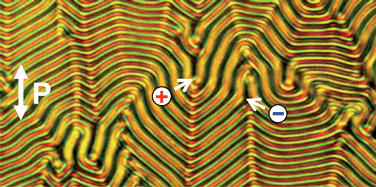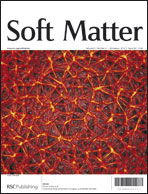Patterned flexoelectric instability in a bent-core nematic liquid crystal
Abstract
We examine here the Bobylev–Pikin flexoelectric instability in an initially planar monodomain of a bent-core nematic liquid crystal, which is negative in conductivity and dielectric anisotropies. Experiments employing dc excitation reveal the domain density to be linear in field, as predicted; however, the instability threshold has a negative temperature coefficient indicating the effective flexomodulus as nonquadratic in order parameter. The dc threshold is also determined as a function of simultaneously acting ac voltage; a theoretical fit is found for the data taking into account elastic anisotropy, whereby the relevant flexoelectric and elastic parameters are estimated. Remarkable morphological changes occur under an increasing field. Half-strength disclinations of opposite topological charge evolve within the flexostructure rendering the wavevector orientation degenerate in the layer plane. Dipolar and quadrupolar topological defect patterns, akin to the singularities in cholesteric fingerprint texture, lead finally to fan like objects. The morphological equivalence between the periodic flexoelectric state and a layered lattice as realized here is attributable to a much lower energy of bend type distortion compared to splay, unlike in a calamitic.


 Please wait while we load your content...
Please wait while we load your content...